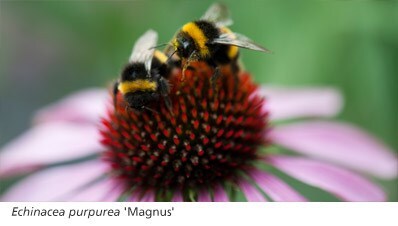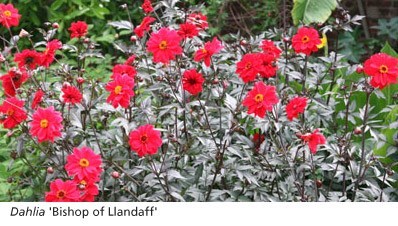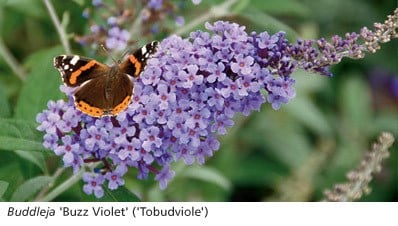|
Late summer is the time that defines a good garden, for if it works then it will look even better in the lower autumn light, which will create its own unique jewel-box richness. If your plot is looking lacklustre, don’t despair as you can transform it by adding some late summer dazzle that will also lure in the bees and butterflies. Late summer is also the best time of all for the painted lady, peacock and small tortoiseshell butterflies - and their presence will add extra charm to any garden.
Aromatic and Nectar-Packed

The insects, bees and butterflies are shopping for nectar as they browse through your garden. It’s the sugar drink that provides enough energy for flight: the ‘lucozade’ of the natural world. You might think that nectar is all the same strength, but certain plants exude highly concentrated sugar-packed nectar whilst others produce watery liquid with hardly any sugar at all. Not surprisingly it’s the sugar-packed nectar that attracts most interest and one plant, Origanum laevigatum ‘Herrenhausen’, is highly sought after. This will light up August with dainty, foot-high sprays of two-tone pink and purple blooms that look pristine for weeks. The foliage is dark-green and crinkled and, as the flowers fade, a black lacy seed head develops, so this is a plant that looks good for months on end. It’s always favoured by small tortoiseshells, a butterfly that is making a revival after a few lean years. There are other forms of O. laevigatum including the all-pink ‘Rosenkuppel’ and the glaucous-leaved, airier mauve-purple ‘Hopleys’. None are as good as ‘Herrenhausen’ though.

Equally essential for August sparkle is Sedum ‘Purple Emperor’, a red-flowered sedum that has neatly crimped dark foliage with a satin sheen. This Sedum doesn’t do the splits and divide like the Red Sea either:  it stays compact reaching between two and three feet. The foliage is dusky from the start and the flowers begin to appear in August, rather than in September as most sedums do. Discovered as a small seedling by nurseryman Graham Gough of Marchant’s Plants, who also named ‘Red Cauli’. Both are bee friendly, but the foliage of ‘Red Cauli’ is not as dusky. Finally the plump leaves of the pigeon-grey Sedum ‘Matrona’ add wonderful substance to any sunny border, especially when placed next to a pink diascia such as ‘Blush Pink’. it stays compact reaching between two and three feet. The foliage is dusky from the start and the flowers begin to appear in August, rather than in September as most sedums do. Discovered as a small seedling by nurseryman Graham Gough of Marchant’s Plants, who also named ‘Red Cauli’. Both are bee friendly, but the foliage of ‘Red Cauli’ is not as dusky. Finally the plump leaves of the pigeon-grey Sedum ‘Matrona’ add wonderful substance to any sunny border, especially when placed next to a pink diascia such as ‘Blush Pink’.
Landing Platforms

Flat-topped flowers such as echinaceas, make perfect landing sites for butterflies and bees and will also add structure to the August garden. These stiff-stemmed flowers with burnished golden middles, go with so many plants and they can either be seed-raised in spring, or planted in potfuls now. The pinks and whites make excellent partners for Sedum ‘Purple Emperor’ and the short variety, ‘Kim’s Knee High’, is the perfect match as far as height goes. ‘Magnus’ is a taller, seed-raised variety but stable enough to produce strong pink flowers. ‘Vintage Wine’ (selected by Piet Oudolf) has an enormous central disk surrounded by bright-pink short petals. Leave them to fade into winter and they are perfectly hardy, being plants of the North American prairie. Echinaceas need winter cold and they resent mild British winters, which can kill them. If you have had trouble with pot-grown plants you’ll find that seed-raised plants, from seeds sown in the spring, can be easier to establish. New breeding has produced a range of echinaceas in tomato-red, peach and pumpkin orange and they include ‘Hot Summer’ and ‘Tiki Torch’. There are also fuzzy doubles, but doubles are not insect friendly. Leave them to fade into winter and they are perfectly hardy, being plants of the North American prairie. Echinaceas need winter cold and they resent mild British winters, which can kill them. If you have had trouble with pot-grown plants you’ll find that seed-raised plants, from seeds sown in the spring, can be easier to establish. New breeding has produced a range of echinaceas in tomato-red, peach and pumpkin orange and they include ‘Hot Summer’ and ‘Tiki Torch’. There are also fuzzy doubles, but doubles are not insect friendly.
Try to plant some Verbena bonariensis too, because this continues to sustain bees and butterflies into autumn with its tall, wiry stems of purple flowers. This makes a good filler, because the upright stems support neighbouring plants. Plant it among the warm-red Dahlia ‘Bishop of Llandaff’ (Treseder 1922) and it will act as supports, negating the need for staking, whilst providing a dazzling display.

The Ultimate Butterfly Magnet
The best butterfly plant of all is the Buddleja, a shrubby plant with fingers of honey-scented flowers. When given a warm, sunny position it will ooze nectar from its slender flowers, which come in many colours. The most attractive to butterflies and bees are the purples, pinks, lavenders and pinkish reds. In theory, one single bush could attract and sustain twenty-two of our fifty-nine British species. That's more than any other plant. If you deadhead the spent flowers every few days, just as they begin to fade, new ones will appear giving you a couple of months of flower. This will also prevent unwanted seedlings popping up too.

Size varies widely, but if you have a smaller garden the diminutive Buzz series can be grown in a Buzz Violet’ has mauve flowers with tiny orange eyes and it will only grow to three feet in height. Add a slow release fertiliser in spring (such as Vitax Q4) straight after pruning, if it’s in a pot. Do not prune any Buddleja in autumn. Always wait until spring has arrived, because a hard winter could lead to losses.
 The slightly larger ‘Lochinch’ (found as a seedling in the Scottish garden of the same name) is also a refined Buddleja suitable for a smaller garden, because it grows slowly. The smallish grey-green leaves frame delicate heads of orange-eyed heliotrope-blue flowers. In milder gardens ‘Lochinch’ keeps its silvered leaves and makes a fine winter spectacle. The slightly larger ‘Lochinch’ (found as a seedling in the Scottish garden of the same name) is also a refined Buddleja suitable for a smaller garden, because it grows slowly. The smallish grey-green leaves frame delicate heads of orange-eyed heliotrope-blue flowers. In milder gardens ‘Lochinch’ keeps its silvered leaves and makes a fine winter spectacle.
The giants of the Buddleja world are named forms of Buddleja davidii, a hardy Chinese species that has given rise to about a hundred varieties. Classics include ‘Royal Red’ (a 1940s’ selection and the closest to red) and the almost grape-black ‘Black Knight’, from 1959. Much newer is the spiraea-pink ‘Pink Delight’, which has enormous flower spikes. These larger buddlejas need hard pruning in spring to keep them compact, cutting back to the lowest buds. After this they will begin to flower in late July, on new growth. However, if grown at the back of herbaceous borders, it’s better to prune these buddlejas back by half. Then they will flower in early July, a full month earlier than hard-pruned plants.
Underplanting Buddlejas

Surround buddlejas with grey-leaved plants that tone with their grey-green foliage. Nepeta ‘Six Hill’s Giant’ produces a billowing haze of sterile blue flowers, so there are no unwanted seedlings. Cut it back and it will flower again within twenty days, perhaps less. The clean, lemon-yellow daisy, Anthemis tinctoria ‘E.C. Buxton’, provides a sharp contrast against the predominate blues, lavenders and purples of most buddlejas. |













